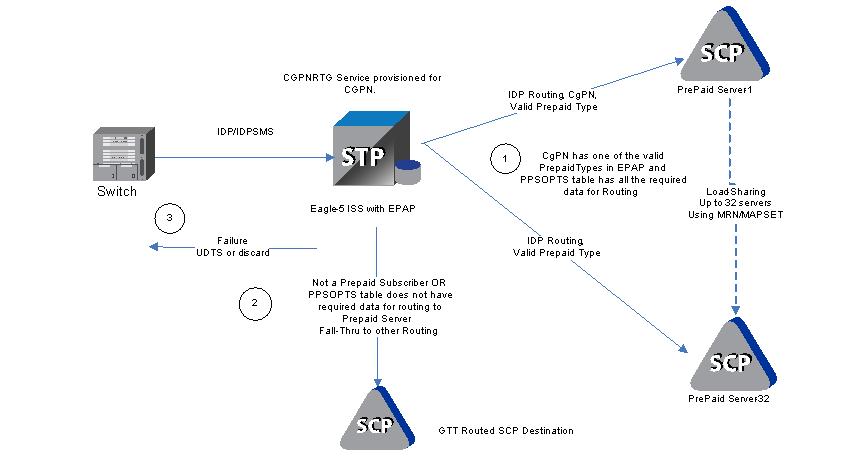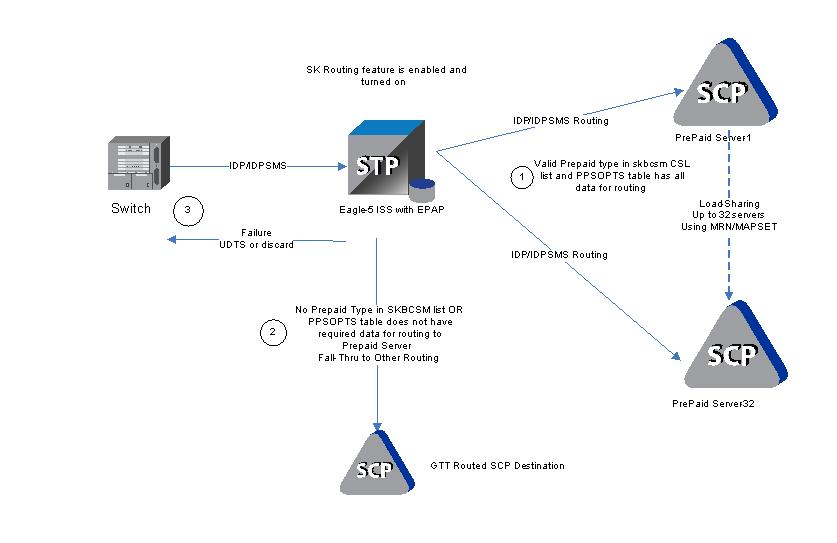Feature Description
- IDP A-Party Routing - Part Number 893033301
- IDP Service Key Routing - Part Number 893033601
IDP A-Party Routing and IDP Service Key Routing are functions of the NPP IDPRCGPN service for IDP Relay that can be used independently and together. When used together, the IDP A-Party Routing function will be attempted first. If sufficient information is not available for routing, then execution of the IDP Service Key Routing function can be attempted as a fall-through option. The IDP Service Key Routing function is attempted as a fall-through option only if that desired behavior is configured. This allows both features to be enabled and turned on, yet only IDP A-Party Routing, only IDP SK Routing, or both can be selected.
Common Screening Lists and SCCP configuration options control the operation of the two features. NPP processing for the features uses the IDP Relay feature IDPRCDPNIDPRCDPN, IDPRCDPN2, IDPRCDPN3, IDPRCDPN4, and IDPRCGPN services and specific Conditioning Actions and Service Actions.
IDP A-Party Routing
IDP A-Party Routing in the vSTP is an extension of the Prepaid IDP Query Relay (IDP Relay) feature that uses the A-Party (CgPN) parameter of an IDP or IDPSMS message to provide a routing alternative to the default SCCP GTA routing.
The IDP A-Party Routing function is provided by an NPP Service Action, and by routing algorithms used during post-NPP processing. The routing algorithms use Prepaid Short Message (PPSOPTS) table data and MRNSET or MAPSET table data.
If all of the required data for A-Party routing is provisioned, then IDP A-Party Routing is attempted. In the case of successful routing, an IDP or IDPSMS message can be routed to one of the available Prepaid Servers from a list of provisioned servers in the MRNSET or MAPSET loadshare table. In the case of a routing failure, either a UDTS is sent back to the originator, or the message is discarded. If all of the required data for A-Party routing is not provisioned, then routing will fall through to either IDP Service Key Routing or GTT routing.
- Successful A-Party Routing to a prepaid server
- Fall-through to IDP Service Key Routing or GTT routing when the A-Party is not a prepaid subscriber or A-Party Routing does not have the complete data required for routing to the prepaid server
- Failed A-Party Routing; either a UDTS is sent back to the originator or the message is discarded
Figure 5-6 IDP A-Party Routing Message Flow

IDP Service Key Routing
IDP Service Key Routing in the vSTP is an extension of the Prepaid IDP Query Relay (IDP Relay) feature that provides a routing alternative to the default SCCP GTA routing during post-NPP processing, either independently or as a fall-through option for IDP A-Party Routing.
IDP Service Key Routing uses the Service Key and EventType BCSM parameters in the the incoming IDP or IDPSMS message, the provisioned prepaid type data in the SKBCSM Common Screening List, and data in the Prepaid Short Message (PPSOPTS), MRNSET, and MAPSET tables.
If all of the required data for Service Key routing is provisioned, then IDP Service Key Routing is attempted. In the case of successful routing, the IDP or IDPSMS message can be routed to one of the available Prepaid Servers from a list of provisioned servers in the MRNSET or MAPSET load share table. In the case of routing failure, either a UDTS is sent back to the originator, or the message is discarded. If all of the required data for Service Key routing is not provisioned, then routing will fall through to GTT routing.
- Successful Service Key Routing to a prepaid server
- Fall-through to GTT routing; either the SKBCSM list or the PPSOPTS table does not have the complete data required for routing to the prepaid server
- Failed Service Key routing; either a UDTS is sent back to the originator or the message is discarded
Figure 5-7 IDP Service Key Routing Message Flow
